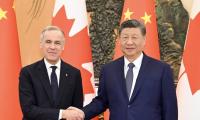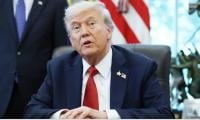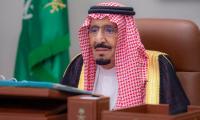G-20 summit: divide and rule policy back in business
The world is facing multipronged problems. The situation compels all the countries to cooperate to sustain the shocks of 21st Century. The slogans like my country first or hegemonic aspiration will not help. It was expected the G-20, one of the leading and powerful economic forums with global relevance, would help find ways for cooperation. It did not happen.
India and the US had other plans. They used the forum to further their hegemonic agenda. They tried to divide the world further to create space for their interests.
The US and India cannot overcome their anti-China and anti-Pakistan obsession. The G-20 summit was another event for them to bring out new tools to undermine China. Both the countries continued to play the corridor game and created a new corridor named “India-Middle East-Europe Economic Corridor” with great pump and show. Indian media declared it a great victory for India, while the Western media and intellectuals are dubbing the initiative as an attempt to counter China's Belt and Road Initiative. It shows that fear of China is a more dominating factor for the US and India than the economic cooperation.
It is not the first time the US joined hands with allies to start such initiatives. The US has been busy in launching such initiatives since 2018. It also used G-7 to launch such initiatives.
First, the US launched the Better Utilisation of Investments Leading to Development (BUILD) programme in 2018 to counter the Belt and Road Initiative. It was designed to achieve strategic and diplomatic interests by using the economy as a shield. The US asked its development agencies to cooperate in implementing the BUILD. However, till today, the programme has not achieved any substantial results.
Second, in collaboration with G-7 members, the US developed the Build Back Better World (B3W) idea in 2021. It was pitched as an initiative to counter the Belt and Road Initiative and undermine China's emerging role. The B3W aimed to meet the infrastructure needs of developing and low-economic countries. The G-7 purposed to invest around $40 trillion by 2035. It was touted as a big initiative that would help overcome global challenges. However, again, B3W could not deliver on the promises. It could not attract funding as the member countries did not contribute according to their commitments. According to sources, till today, it could only attract a few million, which is nothing compared to commitments made by the members.
After the poor performance of B3W, the US and G-7 members presented Partnership for Global Infrastructure Investment in 2022. It was announced that member countries will strive to invest $600 billion and the US will contribute one-third of that.
Third, India joined hands with Japan to come up with its counter initiative to the Belt and Road Initiative. India-Japan in 2017 introduced Asia-Africa Growth Corridor. The document of AAGC stated it would consist of four main components: development and cooperation projects, quality infrastructure and institutional connectivity, capacity and skill enhancement and people-to-people partnerships.
These four components are complementary to promote growth and all-around development in both the continents. Again, it could not deliver on its promises. Even India and Japan could not draw up any meaningful plan for implementing AAGC.
After the failure of successive initiatives, the US and Western allies resorted to the old and time-tested policy of divide and rule. They picked and chose a few wealthy countries of the Global South, convincing them they would be part of the new initiative, India-Middle East-Europe Economic Corridor (IMEEEC). They chose India to host the launch so that Indian markets could be captured. The corridor will aim to connect the Indian market to Europe through the Middle East. And Middle Eastern countries, including Israel, will be connected among themselves through railway network. It is envisioned that through this corridor, the US will be able to counter Chinese influence in the Middle East and beyond. Watching how Saudi Arabia will react to including Israel would be interesting.
Before further delving into IMEEEC, it is necessary to understand why BRI, despite all opposition, succeeded and why initiatives by the US and West could not. The analysis of BRI indicates it is an all-inclusive initiative. It is open to every country without any discrimination. China is not putting any restrictions on any country.
On the contrary, the analysis of Western initiatives suggests four specific reasons hindering previous initiatives' progress. First, these initiatives were exclusive. The US and Western countries engaged selective countries. They also made sure there should be no place for China. It is a perfect example of block mentality.
Second, these initiatives were not supported by concrete actions and financial resources. There was no effort to pool the resources. The US or the West could not contribute according to their commitments. Third, these initiatives were designed to achieve strategic interests using economic shields. Fourth, all initiatives were China-focused and had a single goal: undermine China at any cost. It weakened initiatives' ability to forge economic partnerships and make meaningful progress.
Regrettably, the US, West and India did not learn from the past. They presented the IMEEEC. It is another attempt to create an exclusive club of a few selective countries. The member countries of the initiative did not even bother to invite Pakistan to join the corridor.
The location of Pakistan makes it an ideal country to create an efficient link between the Middle East and India, but they ignored it. However, this time strategy is a little different from the past. The US and its allies picked new members from the Global South, especially in the neighbourhood of China. They are trying to create an exclusive club to check China's peaceful rise.
However, like in the past, chances of success of IMEEEC are meager because the real problem is availability of financial resources. We know the US and its allies have failed to mobilise the required resources for the B3W, BUILD and Partnership for Global Infrastructure Investment. India and Japan too could not bring the needed financial resources to the table to implement the Asian-Africa Growth Corridor. Hence, we should wait to see how IMEEEC will raise the financial resources and who will contribute the resources. One can expect Saudi Arabia and UAE will bring in money. But, the real question is how much can they contribute? B3W needs $40 trillion and PGII $600 billion. Chances of success are meager.
China is also acting as a pull factor for global growth, as the IMF estimated China alone will contribute 34.6 percent to global growth. The same country is excluded from all the plans for the future.
China is the biggest importer of Saudi and UAE oil. The country has also emerged as a major investor in the UAE and Saudi Arabia. In this context, we must wait and see how both the countries play their role in IMEEEC and maintain their relationship with China.
It is feared it will be the beginning of a new Cold War because the ultimate objective of the US is to contain China.
If so, it is not good news for the Middle East and India. The Middle East, already home to multiple conflicts and problems, cannot afford to be the turf of new Cold War. It will also be a serious blow to the recently signed agreement between Saudi Arabia and Iran.
For India, it will be a lose-lose proposition. On the one hand, India will not be able to benefit from the biggest consumer market in the neighbourhood. On the other hand, it will become a frontline ally against China, and Washington will always push Delhi to do more. It can also lead to a hot conflict in the region, extremely bad for India.
From the above discussion, we can infer the US and its allies have successfully divided the countries and will accelerate efforts to divide them further. They deem it necessary to contain China. Against this backdrop, Pakistan must follow the situation closely, expecting Saudi Arabia and the UAE will invest in the country.
New developments indicate both the countries may have other preferences. Besides, there may be pressure on Pakistan to come out of CPEC and limit engagement with China. Thus, Pakistan needs to keep a close eye on the situation.
-
 Michelle Randolph Clears The Air On Dating Rumours With Glen Powell
Michelle Randolph Clears The Air On Dating Rumours With Glen Powell -
 Viral 2016 Throwback Trend Taking Over Instagram And TikTok: Here's Why
Viral 2016 Throwback Trend Taking Over Instagram And TikTok: Here's Why -
 Wizards Vs Kings: Domantas Sabonis Returns After 27-game Absence
Wizards Vs Kings: Domantas Sabonis Returns After 27-game Absence -
 Bella Hadid Shares Future Plans Following 'Yellowstone' Success
Bella Hadid Shares Future Plans Following 'Yellowstone' Success -
 NLL Brings Professional Lacrosse Back To Edmonton After 10 Years
NLL Brings Professional Lacrosse Back To Edmonton After 10 Years -
 Marcello Hernandez’s Girlfriend: What To Know About Ana Amelia Batlle Cabral
Marcello Hernandez’s Girlfriend: What To Know About Ana Amelia Batlle Cabral -
 Sources Dish On Andrews Plans For Life After Exile To A Falling Down Dump
Sources Dish On Andrews Plans For Life After Exile To A Falling Down Dump -
 Snow Storm Warning In Ontario’s Weather Forecast Through Tuesday
Snow Storm Warning In Ontario’s Weather Forecast Through Tuesday -
 Canada And China Trade Deal: All You Need To Know About The New Agreement
Canada And China Trade Deal: All You Need To Know About The New Agreement -
 Tyler Hilton, Megan Park Call It Quits After 10 Years Of Marriage
Tyler Hilton, Megan Park Call It Quits After 10 Years Of Marriage -
 Prince Harry’s Fears Turn Concerning As Archie, Lilibet Slip Too Far Out Of Reach: ‘Their Too American’
Prince Harry’s Fears Turn Concerning As Archie, Lilibet Slip Too Far Out Of Reach: ‘Their Too American’ -
 Former Nickelodeon Star Kianna Underwood Dies At 33 In Tragic Hit-and-run
Former Nickelodeon Star Kianna Underwood Dies At 33 In Tragic Hit-and-run -
 Prince Harry Risks Straining Marriage To Make Archie, Lilibet Make Emotional Demand Of Meghan
Prince Harry Risks Straining Marriage To Make Archie, Lilibet Make Emotional Demand Of Meghan -
 Sarah Ferguson’s Pal Reveals What She Really Thinks Of Beatrice, Eugenie Choosing A Royal Christmas
Sarah Ferguson’s Pal Reveals What She Really Thinks Of Beatrice, Eugenie Choosing A Royal Christmas -
 North West Raps About Piercings, Tattoos And Skipping School In New Song
North West Raps About Piercings, Tattoos And Skipping School In New Song -
 Teddi Mellencamp Shares Hopeful Health Update Amid Cancer Battle: 'Cloud Is Lifting'
Teddi Mellencamp Shares Hopeful Health Update Amid Cancer Battle: 'Cloud Is Lifting'



